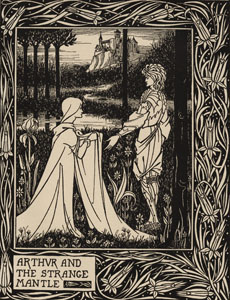Black and white is hardly ever just black and just white. As in an author’s tale in words, selection and choice of just the right word can incite a myriad of impressions in a reader well beyond what the author may have originally intended. For George Cruikshank, Aubrey Beardsley, Howard Pyle and Willy Pogány, black and white became the color palette to stir a reader’s imagination down paths other than where the author’s words might lead. At times, the stark contrast between absolute black and unmitigated white awakened or startled the reader to the author’s intent, more than mere words could do. At other times, an illustrator’s use of sliding scales of grey allowed a reader to experience more reality than an author might normally intend in a fairy tale, legend, or horror story. Even artists such as Rackham and Harry Clarke would eschew color when the author’s words seemed more impactful if drawn or imagined in black and white. Compare the images here with those in Rackham’s Poe for his intentional use of black and white rather than color to convey the author’s intent.

|

|

|
|
Sir Thomas Malory and
Aubrey Beardsley Arthur and the Strange Mantel from Sir Thomas Malory’s Morte D’Arthur (Vol. 1) J. M. Dent 1893 8 in. x 6 ½ in. 823.2 M257m 1893 Harold and Mary Jean Hanson Rare Book Collection |
Edgar Allan Poe and Harry Clarke
The boat appeared to be hanging, as if by magic, … upon the interior surface of a funnel from Edgar Allan Poe’s Tales of Mystery and Imagination J. J. Little & Ives Company 1933 8 in. x 6 in. PS2612 .A1 1933a Harold and Mary Jean Hanson Rare Book Collection |
Edgar Allan Poe and Arthur Rackham
Untitled from Edgar Allan Poe’s Tales of Mystery and Imagination George G. Harrap & Co. Ltd. 1935 7 ¼ in. x 5 ¼ in. PS2602 1935b Harold and Mary Jean Hanson Rare Book Collection |


